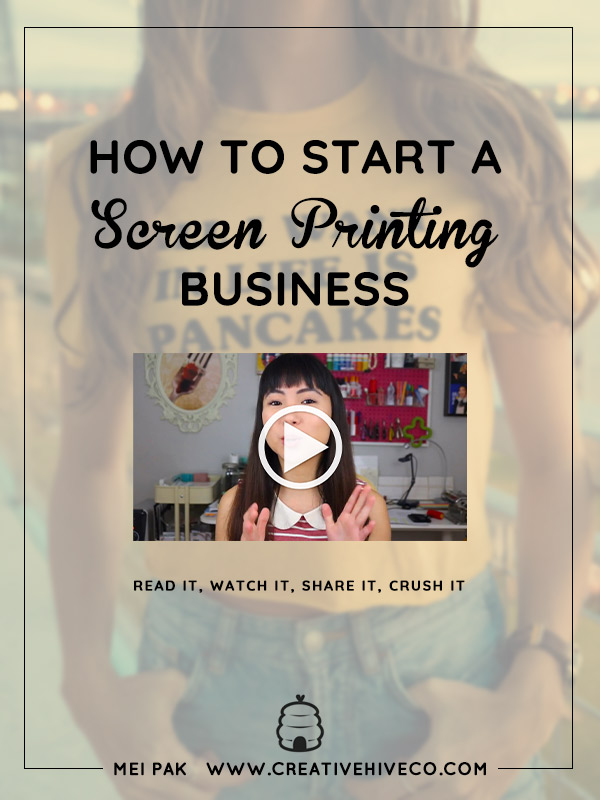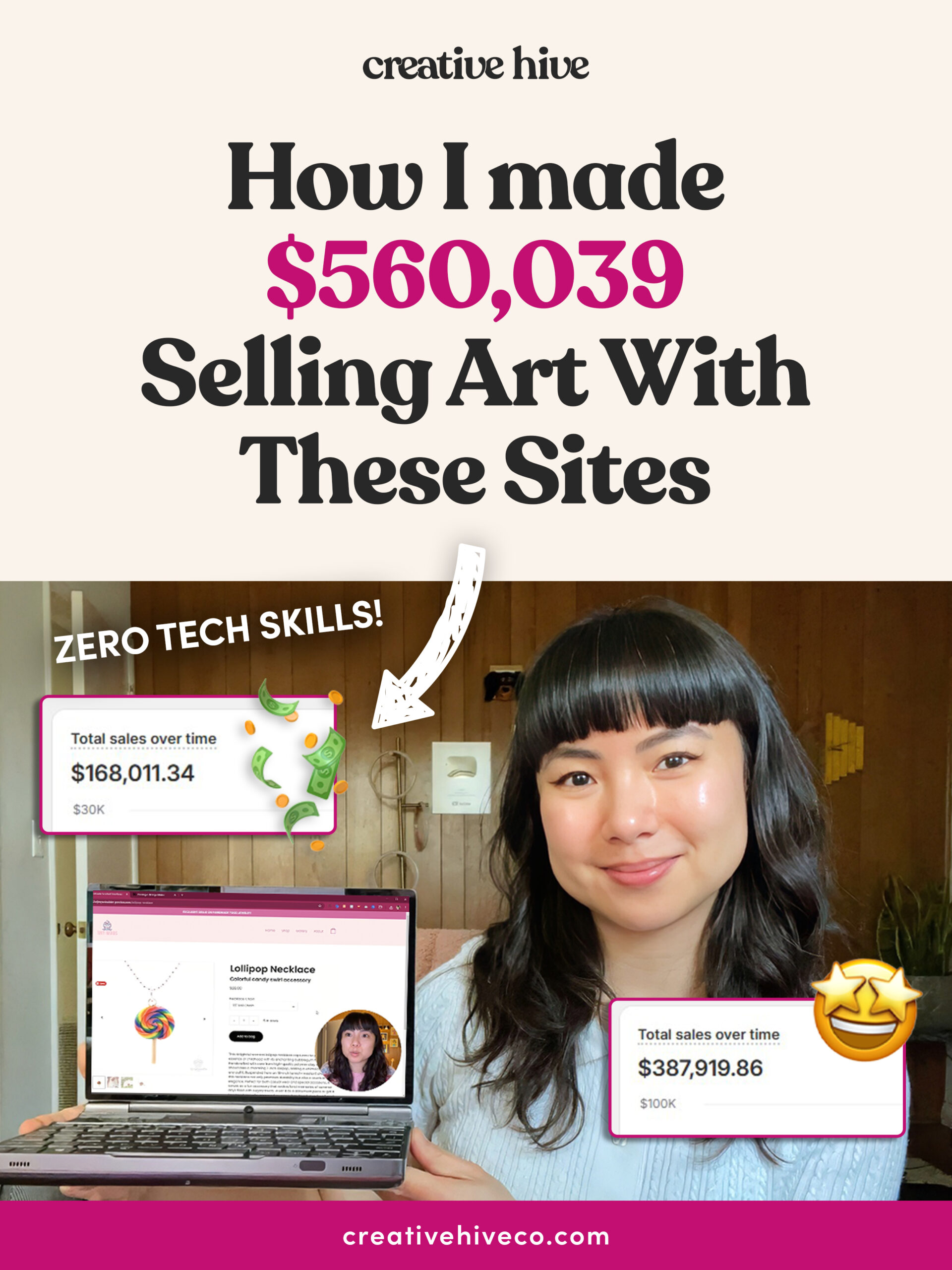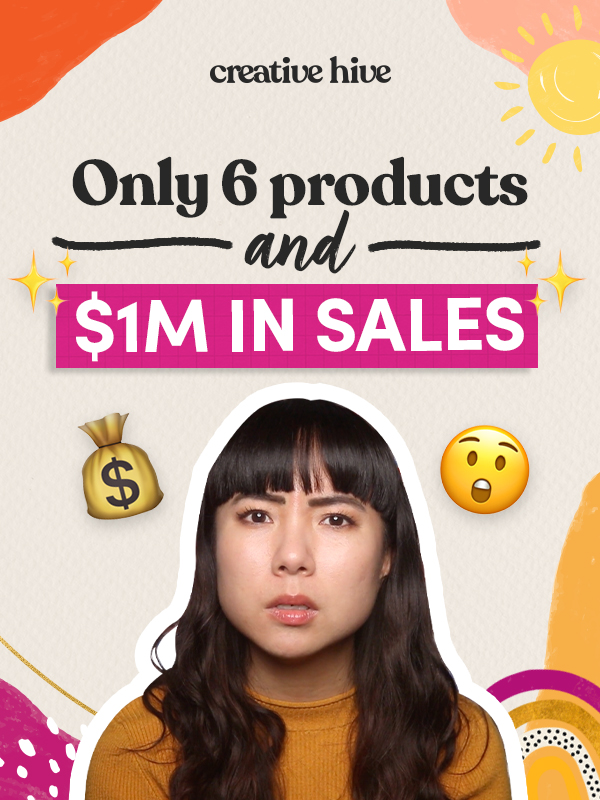I want to help you build a sustainable, profitable handmade business that makes you consistent income and sales. I only ever teach or recommend marketing, social media, pricing, production and branding tips that I’ve personally used successfully in my own 7-figure handmade businesses.
I'm Mei, from Los Angeles!
Read More
Popular Posts You'll Love
Looking for something?
Categories
starting a business
get more traffic
running a business
make more sales
branding
growing a business
mindset & productivity
podcasts
pricing & money
product photography
reviews
selling on etsy
selling on amazon
social media
selling wholesale
- Facebook2
- Twitter0
- Pinterest95
- 97shares
If you’re interested to start your own screen printing business online, I’m going to show you exactly:
- how to get started
- what challenges you need to consider
- what you need to get started with
- how you can get yourself set up with success
I make multiple six figures in sales every year, but I also made a ton of mistakes! I know what works and what doesn’t and I’m going to share that with you today.
Advantages
I think it’s a great idea to start a screen printing business. There are a lot of advantages and a wide range of product opportunities.
You can screenprint on fabric, like tote bags and t-shirts, or on paper making greeting cards and posters. While those are the most common mediums you’ll see, it’s totally up to you to get creative!
You can screen print on glass to make awesome pint glasses that sell in breweries, or just to make beautiful glassware for the kitchen. There is really no limit except for what you can do with your equipment.
I also love that, in general, you’ll be pricing your items at a comfortable price point, meaning, you aren’t trying to sell a $2,000 item. You’re looking at items in the double-digits, which means that your items are likely to be accessible to a large audience.
People are always buying t-shirts, tea towels, and posters, so your product is going to have a wide market.
Plus, there’s the whole world of custom products you can get into if you want. Remember I mentioned that brewery idea? And once you’re making a few designs for restaurants or businesses, you’ll have repeat customers locked in!
Because screen printing is, in essence, printing lots of copies of the same design, once you do the upfront set-up, you’re in a great position to make large quantities of the same item. Compared that to, say, a knitted hat business, where you’ll spend hours making each hat, with a screen printing business, you’ll do a lot of initial set up for a design, but once that’s done, you can continue making posters or t-shirts in relatively little time.
It’s truly a business destined for long-term growth, and I’m always a fan of that!
Challenges
Now, while there are some great advantages, there are a number of challenges that you need to think about. The biggest challenge with starting a screen printing business is the upfront cost of the equipment and space.
To do screen printing, you need at minimum, a computer with graphic software and a printing press. That’s just the bare minimum. To work at a production level, you’ll need screens for drying and that doesn’t just squeeze into the corner of your living room. You’ll probably need a separate space like a garage or spare bedroom.
None of that is cheap.
Look to spend about $500 to get started, plus whatever space you need, and be ready to upgrade as you want to include more colors or options.
Screen printing is a really interesting business because it has two separate facets. One is the actual printing, which is the production side, and the second is the creation of the art work.
Almost all successful screen printing businesses create their own artwork for printing. Whether it’s working with an artist, using purchased graphic elements or illustrating your own, it’s the artwork that really distinguishes your product.
Without distinctive art, you’re just running a production business.
It can definitely take time to develop a unique artistic aesthetic that gains a following.
I want to mention that if you’re really jazzed about making custom t-shirts, but aren’t sure the screen printing business is right for you, it might be worth investigating fabric transfers. It’s a similar business idea that allows you to create custom items, but without the same up-front cost of screen printing. Transfers don’t entail you making the same design over and over again to be profitable, so this may be the path for you if one-offs are more in line with your ideas.
Equipment
So as I’ve mentioned, with screen printing, equipment is a huge deal. I’m not going to pretend I have the best advice on selecting a printing press, but TShirtChick has an amazing series of videos (start with this one) and she tells you everything you’d want to know about selecting a press, inks and you can even see her screen setup.
She is a wealth of knowledge so I highly recommend you check her out.
Your equipment is the most expensive outlay for your business. It’s worth having a look in your local classifieds (like craigslist) to see if there is used equipment in your area for sale. As other printers upgrade, you may be able to snatch a deal!
Products
Okay, now let’s talk about the products that you’re going to stock in your shop.
This may sound completely obvious, but I’m going to say it anyway because I see a lot of business owners go wrong here.
You need to offer products that people actually want. If your items aren’t in demand, they aren’t going to sell.
How do you figure out what people want? I have a secret that I’ll share with you in a minute. But first, let me finish up talking about what you should offer in your shop.
Once you have a few product ideas, you want to think about what they share in common so that your shop has a cohesive message.
For screen printing, your niche will most likely be determined by your unique artistic style.
Okay, so how do we find out what is going to be popular? I’m going to tell you a secret that feels kinda sneaky but really isn’t. Spy on your competition.
That’s right. Search Etsy and see what’s popular.
Of course, you’d never copy what other people are doing, but you’re doing research to see what’s popular right now.
Are tea towels going like crazy right now? Then maybe that’s worth a try.
Once your artistic style is set, you’re really fortunate because you can experiment with different products and see what’s working for your audience.
Etsy is an easy place to do your research, because so much of the information is public! You can see how many sales a shop has, how long they’ve been in business and how many times an item has sold. It’s also easy to browse across categories to see what’s trending. That’s amazing information you won’t get by looking at individual standalone websites.

Making Your Products Stand Out
Okay, so you’ve narrowed down your product ideas to items that you’re able to make and that you’re pretty sure people will want to buy. Now, let’s keep pushing harder.
To be successful, you’ll need to make sure your products stand out. I think of it as adding my own special sauce.
In my handmade business, Tiny Hands, one of my special sauces is the scent. If you don’t know already, I make handmade scented, polymer clay food jewelry, like the maple-syrup scented waffle necklace that Leslie Knope wore on Parks and Recreation.
The scent makes my products stand out from the rest. You may not believe it, but food-shaped jewelry is a crowded space. Yet, very few people do scented jewelry. That’s my special sauce and it’s what my products are known for.
What special sauce can you add to your products:
- Are you known for a unique color palette?
- Amazing gift wrapping?
- A steampunk theme?
It could be a little thing like adding leather tags to finish off your pieces. Whatever it is, you want someone to see your products and say, ‘that’s so-and-so’s!’.
I hope your creative juices are flowing about your new business. If you’re feeling stuck, no worries. Just keep reading and promise yourself you’ll set aside some brainstorm time. I always get great ideas in the shower or on walks, so don’t be surprised if your best ideas come to you at the craziest times!
I’m going to drill down into the details now, because it’s the details that’ll help your business be a success.
Pricing
For your shop to be successful, you need to be able to earn enough money. Sounds obvious, but it requires some calculations.
There are three things you need to think about when it comes to pricing:
- how much you can earn per hour
- how much you can earn per week
- how much the market will bear
How Much You Can Earn Per Hour
For how much you can earn per hour, you’ll want to have a look at my pricing video which walks you step by step through how you should be pricing your products so you’re earning a solid hourly wage.
I see so many business owners pricing their products too low and not factoring in profit for their business, so you don’t want to make that mistake!
How Much You Can Earn Per Week
Now, let’s talk about how much you can earn per week. Let’s say that you’ve calculated that you can earn $20 per hour and you’re happy with that. You have to think of your week as a whole.
Can you really print for 8 hours a day for 5 or 6 days a week? Maybe you can.
Do you have the cash flow to keep that much raw stock in your house? And store it all? When are you going to do your other business stuff?
It’s important to think of how many hours you can practically print to produce your products and decide if that’s suitable for your life.
How Much the Market Can Bear
Now, the third component, how much the market can bear. That is, will people buy your products at the price you need to sell it to make a living?
This is where the research you did on your market will come in handy. It’s also where having great special sauce ideas to elevate your product from a so-so commodity into luxury with no competition, is incredibly valuable.
If you‘ve done your research or maybe even experimented in your own shop and you suspect that you won’t be able to sell your printed t-shirts for the money you need to make it worth it, it might be time to go back to the drawing board and brainstorm new product options.
Equipment in Detail
We chatted a bit about the equipment and I pointed you to TShirtChick, who has you covered for equipment recommendations.
For your screens, you can make them yourself, or if this isn’t your jam, search ‘screen burning service’ and you’ll find shops that will make your screens for you. Anthem Printing is one place that does it. It’s a great option if you want to take that component off of your plate.
Now, as for the items you’re printing on, these materials will be the largest part of your monthly operating costs. I sometimes see people go into a big box store and buy blank t-shirts or tote bags at retail prices! That’s a very hard way to run a successful business.
When you purchase an item from a retail store, that the shop takes about half of the cost of the product. The wholesale price on many items is about 50% of the retail price.
That’s why, it’s crucial to think about your supply chain.
If you’re running a business and using significant quantities of an item, you should be able to purchase directly from a supplier and cut out the retail middle man.
You might be buying t-shirts, pint glasses, or tote bags, so I’m not going to be able to give you specific sources because this business is so varied.
As a starting point, I recommend two things.
- Search ‘wholesale [your item]’ and just see what comes up. It’s quite likely there’s a place near you that has what you’re looking for.
- I always search Alibaba and Aliexpress when I’m looking for bulk supplies. Alibaba puts you in direct contact with factories overseas, and you won’t get better prices, especially if you’re in need of serious quantity.
I think it’s important to mention quality and your secret sauce. Your supply chain is the starting point of everything you make. You’ll likely find that a crappy t-shirt and a really nice t-shirt are only a dollar or so apart in price at the wholesale level.
A customer will happily pay $10 more for a luxury shirt than a crappy one and you’re doing the same work for each! Think carefully about your quality and pricing when choosing your supplies.
Shop Brand
Once you have your products in place and a cohesive shop brand, you’ll want to create a library of marketing materials that you can use in your shop and in social media.
If you want to hear me go on forever about how much more awesome your own website is compared to Etsy, then you’ll want to pop over to this video here. In short, Etsy is fine and can even be a good place to start, but I want you to have your sights set on launching your own site.
Photography
You want a collection of great product photographs of your items. Photos on a white background are great photos to have on your website. It’s also great to get what are called ‘lifestyle photos’, which are your items in real-life situations. Like, someone wearing your shirt, your artwork in a frame or a person carrying a tote bag.
These photos are great for social media and they also help the customer picture your item in real life.
You don’t need to hire models, asking a neighbor to hold an item in their hands in good lighting is good enough to get you started.
Logos
If you’re struggling over your logo, head to somewhere like Creative Market or Fiverr.
You can get either a template to use yourself or have someone else use a template to make you a logo. They’re surprisingly custom-looking and usually modern and on-trend!
You don’t need to spend thousands of dollars on this in the beginning. I’ve been running Tiny Hands for fourteen years now and I’ve never hired a professional to do my branding or logo.
Marketing
Once your business is open, it’s time to promote it! This is a whole topic of it’s own that we can’t cover here right now, but I have an entire marketing playlist of videos to get you started with how to promote your shop. Having said that, I’ll cover the absolute basics here.
Email List
First, you’ll want an email list. You can use something like MailerLite to host a list up to a thousand for free.
An email list has the highest conversion rate of any free, organic marketing.
That means, you’ll get the most sales per email, and it’s one of the only marketing avenues that you actually own.
Facebook could shut down tomorrow (or change the algorithm) and all of your fans are no longer there or they’re not seeing your posts anymore. So start an email list and put a sign up box on your site even if you aren’t actively sending emails, yet.
Pitch Your Products
Second, you’ll want to start reaching out to magazines, influencers, bloggers and anyone who has a large audience of your customers and offer to send them a free product in exchange for talking about you in front of their audience. This is going to be one of the faster ways to get people to come over to your new site.
Okay, I’ve told you everything you need to know, so it’s smooth sailing, right? Not really.
Things may go awesome right away, but more often than not, building a business takes time. Maybe the products your research indicated would be bestsellers aren’t. Maybe your supplies are turning out to be too expensive. Maybe certain items are taking longer to make than others.
Success is about constantly analyzing what’s working and what isn’t.
Give things a bit of time, but if they aren’t working, don’t be afraid to go back to the drawing board and do some revisions. I’ve seen a lot of businesses that took quite a few tweaks to things flowing, but they’re stronger for it.
So stick with it. It’s a long term game.

Leave a Comment
Liked this article? Share it!
Unlock a Profitable Handmade Business
in Just 12 Weeks Without Using Etsy
or Social Media
FREE WORKSHOP
This workshop is for anyone who makes and sells a handmade or physical product, including jewelry designers, artists, paper designers, bath & body product makers and more!
What You'll Discover
The #1 mistake people make with Etsy & social media that causes shops to FLOP
The secret to making it with your handmade shop so it's no longer just a hobby
How to make sales in your handmade shop with ease so you can finally get to 6-figures
TAKE ME THERE
Your email address will not be published. Required fields are marked *
Leave a Reply Cancel reply
About
Blog
A Sale A Day
Student Login
Free Class
Contact
Terms
Become A Student
Watch On YouTube
Student Reviews
See My Handmade Shop!




Are you still stuck with paper labels for your product’s bottles meanwhile your rivals have moved to direct prints on theirs?
Don’t worry because we got you covered!
This article will introduce you to silk screen printing and the benefits of silk screen printing.
I think marketing is really important to promote our bussiness
Your website is very inspiring with high-quality content. We are sure that you will find additional useful information on our website. Come on, visit us at Konveksi Seragam Kerja and we can collaborate with each other.
Warm Regard.